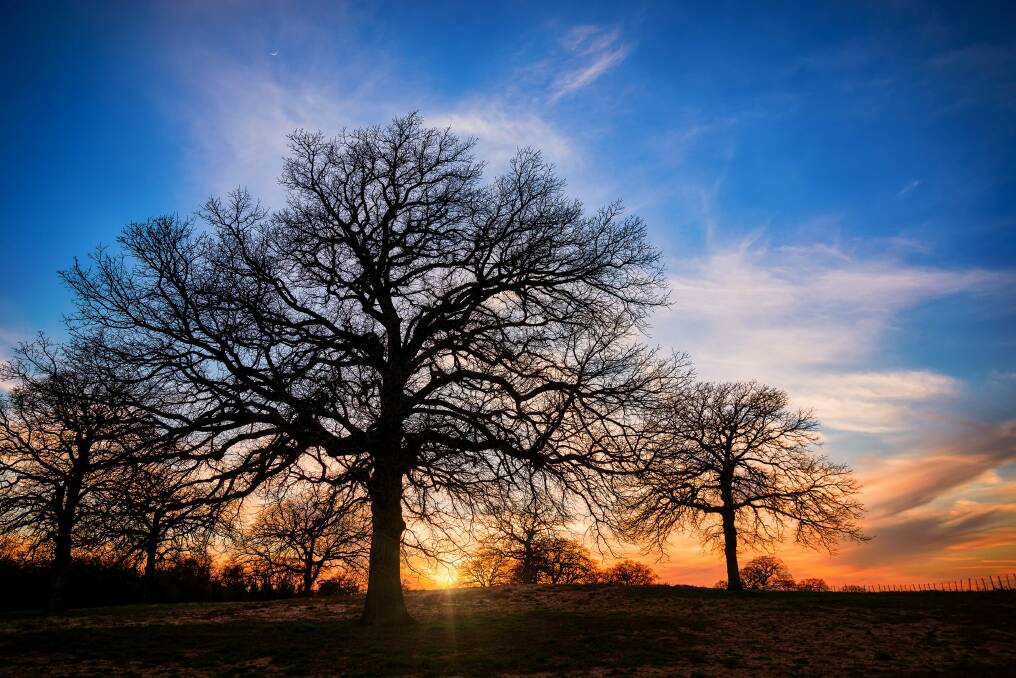Mid-winter is nude tree time. Or 'unclad', if you prefer. The leaves of deciduous trees have dropped, apart from a few stubborn ones like pin oaks where the leaves hang brown and wrinkled until the next gale blows them into your gutters, or the new spring leaves push them off – whichever comes first.
Subscribe now for unlimited access.
$0/
(min cost $0)
or signup to continue reading
It may seem odd that just as the rest of the world rugs up in clothes, if human, or layers of fat, if you are hibernating bear, or fluffy undercoats, if you are a wallaby or wombat, trees drop their leaves.

But when the world turns cold deciduous trees stop trying to drag up nutrients from the soil and desist from the hassle of photosynthesising just to produce new growth that will freeze 10 seconds later. They basically (almost) stop. (Many Aussie trees do much the same in a drought: drop their leaves, some or even all, and just wait it out.)
Deciduously nude branches are exactly what you need in winter: sun, instead of shade. Many trees also have sculptural elegance that you don't notice in summer when they are leafy or in blossom, like the neat umbrella of persimmons, the dappled bark of crepe myrtle bushes/trees, silver birch which is indeed silver and twisted willows which, yes, are a weed unless left in mid-city gardens in a pot, away from watercourses.
Other trees with noteworthy bark and underlying geometry that become noticeable in winter are Japanese maples as almost all varieties reveal interesting branch and trunk architecture especially as they age; many of the cherries, particularly Prunus serrula, for their polished looking reddish-copper coloured bark; Acer griseum the paperbark maple, that has spectacular peeling copper coloured bark; and for those with space and patience, the sight of large, bare oaks and elms can lift the heart on a cold, grey day.
This is also the best time to plant deciduous trees: not necessarily better for the tree – easing it gently out of a moist pot at any non-extreme time of year, settling it in firmly then watering well, is preferable from the tree's point of view.
But it is far cheaper to transport bare-rooted trees – you can tie a dozen in a bundle that takes up as much or even less space than one potted tree and is far lighter. This isn't exactly optimal – no one, with or without leaves, likes being pulled out of familiar surroundings – but a nude tree is not doing anything much, except sitting there. It can be transplanted and hardly show it has been disturbed, as long as the roots haven't dried out, as it's not taking up much water or nutrients.
If you (or those who transported or stored it) have let the roots dry out, soak the tree in water for forty-eight hours and cross your fingers. If the roots are damaged, trim them – a trimmed bare end is better than a larger damaged one that the tree is trying to heal.
Then wait. Planting an entirely nude tree: no leaves, bare roots, not even a bud or two – is the true test of gardening faith. Come spring it will grow, or else you can try to get your money back. And by spring or summer you may get blossom and, in a few years, you will get whatever glory you chose it for, be it flowers or fruit or stunning foliage to block the neighbour's view of your bathroom. Though, come to think of it, an evergreen may be better for that, unless you give up bathing for winter. And while an evergreen will be potted, it too can be planted now, ready for that strange spring phenomenon when things grow. And grow. And given just a bit of tending, keep on doing it.
This week I am:
- watching the lyrebird still advance bravely to attack its reflection in the living window, squawk loudly then retreat, terrified, leaving long streaks of white droppings – think Disney's Road Runner on steroids and, no, the tail does not look elegant at all except for fleeting moments of maximum display, mostly for the benefit of other competing males;
- eating walnuts that I had forgotten we'd harvested;
- not eating quinces, as I forgot to harvest them and, also, I still have a frozen container left from last winter – NB must use or dispose of it … probably the latter;
- deciding that spring onions should better be named 'winter onions' as that is when the delicious green leaves are most valuable;
- still carefully eating Jerusalem artichokes, baked and crisp, and not too many … truly; and
- not planting anything, or hacking back anything, though if I were this would be a good time to try to tame the loganberries and pull out all the vines that are trying to take over the vegetable garden.
f. @jackiefrenchauthor
t. @jackie_french_
i. @jackie_french_

